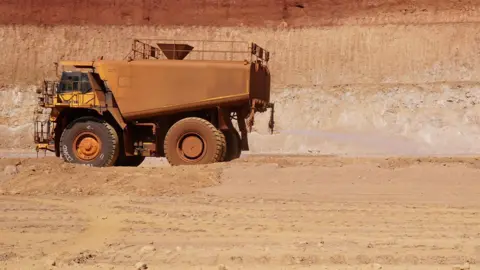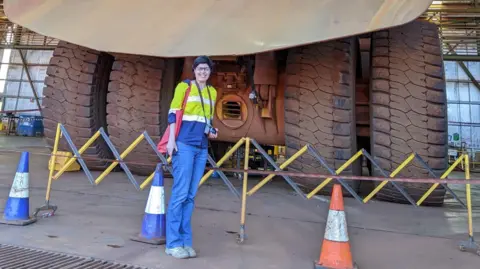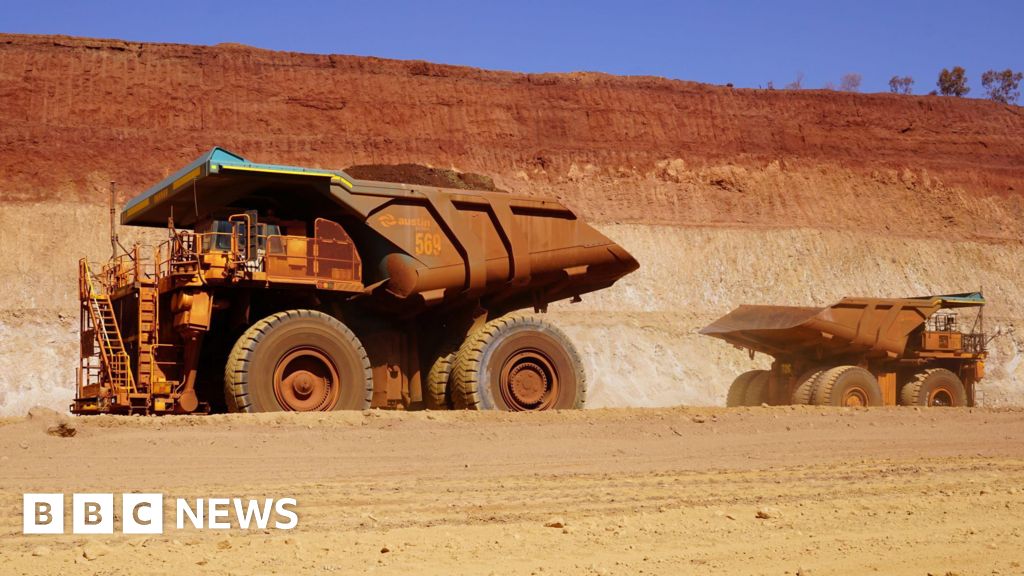 Zoe Corbyn
Zoe CorbynIt doesn’t get much further than that. I’m in outback Western Australia at Rio Tinto’s Greater Nammuldi iron ore mine.
It’s a two-hour flight north from Perth to a region called the Pilbara.
Nobody lives here forever. About 400 workers are on site at any one time, and they are flown in, working four to eight days, depending on their shift pattern, before flying home.
Giant trucks the size of townhouses, capable of hauling 300 tons, crisscross the red earth roads in different sections of this open pit mine complex.
For an outsider like me, their size is quite intimidating, but multiplying that feeling is the knowledge that there is no driver behind the wheel.
During a tour of the site in a full-size company vehicle, one of the trucks comes into view, approaching from a side road.
I sigh in relief as he deftly turns and continues in the direction we just came. “Did it make you feel uncomfortable?” asks truck driver Dwane Pallentine, a production supervisor.
 Zoe Corbyn
Zoe CorbynGreater Nammuldi has a fleet of more than 50 self-driving trucks that operate independently on predetermined courses, along with a small number that move manually and work separately in a different part of the mine.
Also on trial is an autonomous water cart affectionately known as the Henry, which, along with hand-operated ones, sprays mine roads to keep dust down.
The company vehicle I’m in is only able to operate alongside autonomous trucks because it’s equipped with high-precision GPS, which allows it to be seen within a virtual system.
Before entering the closed autonomous mine area, we logged into this system and a controller verified by radio that we were visible.
It has wrapped our vehicle in a virtual bubble that the self-driving trucks “see” and that makes them manage their proximity by slowing or stopping as needed.
A touch screen in our cockpit displays all manned and autonomous vehicles and other equipment in the vicinity, along with “permission lines” that show the immediate routes the self-driving trucks intend to follow. Had I looked at the screen instead of worrying, I would have seen the truck come back.
In addition to all vehicles being equipped with a large red emergency button that can stop the system, the autonomous trucks have lasers and radars front and rear to detect collision hazards.
Sensors also detect obstacles. If a large rock fell from the back of one truck, sensors on the other truck would notice it and the vehicle would stop.
However, some trucks seem overly sensitive – on my tour I see a couple simply stripped from rough roads.
Coordinating and monitoring these robots is Rio Tinto’s Operations Center (OC) in Perth, about 1,500 km (930 miles) to the south.
It is the nerve center for all of the company’s Pilbara iron ore operations, which comprise 17 mines in total, including three that make up Greater Nammuldi.
Led from here by controllers, include more than 360 self-driving trucks in all countries (about 84% of the total fleet is automated); a largely autonomous long-distance rail network to transport mined ore to port facilities; and nearly 40 autonomous exercises. OC staff also remotely monitor plant and port functions.
Autonomy is not new to Rio’s Pilbara operations: the rollout began in the late 2000s.
Nor is it unique: Australia has the most autonomous trucks and other mining equipment of any country, and other mining companies in the Pilbara are also using the technology.
But the extent to which Rio has grown its operations so far, including Greater Nammuldi – which has one of the largest fleets of autonomous trucks in the world – gives it global significance.
And it’s a global trend. According to GlobalData the number of self-driving haul trucks worldwide has roughly quadrupled over the past four years to more than 2,000, with most of them made by Caterpillar or Komatsu.
 Rio Tinto
Rio TintoThe biggest reason for introducing the technology has been to improve the physical safety of the workforce, says Matthew Holcz, managing director of the company’s Pilbara mines.
Mining is a dangerous occupation: heavy machinery can be operated unpredictably by people who can also get tired. “The data clearly shows that, through automation, we have a significantly safer business,” says Mr. Holcz.
It has also improved productivity – by about 15%, he estimates. Autonomous devices can be used more because there are no gaps due to switching changes or breakdowns. And autonomous trucks can also go faster when there is less staff-driven equipment on the scene.
Such automation does not come cheap. Rio will not disclose what it has spent in total on its Pilbara automation journey to date, but observers estimate it to be in the multi-billion dollars.
Meanwhile, employment opportunities have evolved. Narrative could be one of the bots taking jobs, but it doesn’t look like it so far.
While OC has about one controller for every 25 autonomous trucks – according to Rio, no one has lost their job due to automation.
Instead, there has been redeployment: truck drivers have joined the OC as controllers themselves, retrained to operate different pieces of equipment, such as excavators, loaders and dozers, or gone to drive manual trucks in different locations .
On the large open-plan floor of the OC, among banks of monitors arranged in clusters for various mines, I meet Jess Cowie, who used to be a manual driller but now runs the autonomous ones from the central drill pod. “I still put holes in the ground… just without the dust, noise and being away from my family,” she says.
 Zoe Corbyn
Zoe CorbynAutomation is bringing a “step change” to safety in the mining industry, says Robin Burgess-Limerick, a professor at the University of Queensland in Brisbane who studies human factors in mining. But that doesn’t mean there isn’t room for improvement.
Professor Burgess-Limerick has analyzed incidents involving autonomous devices reported to regulators.
As he sees it, the interfaces used by staff both in the field and in control centers to get information are not optimally designed. There have been situations where field staff have lost situational awareness, which better display design could have prevented. “Technology designers need to make a little more effort to consider people,” he says.
And there’s also a risk that controllers’ workloads can be overwhelming – it’s a busy, high-stakes job.
Overconfidence, where people become so confident that autonomous devices will stop that they start putting themselves at risk, can also be a problem, and he notes that efforts should be directed at improving the trucks’ own ability to detect moisture. There have been incidents where wet roads have caused them to lose traction.
There can be legitimate safety concerns with autonomous equipment, says Shane Roulstone, co-ordinator for the Western Mineworkers Alliance, which represents mining-related workers in the Pilbara.
He tells of a serious incident this May where an autonomous train crashed into the back of a broken-down train that workers at the front were repairing (they evacuated before it hit, but were left shocked) .
But Roulstone also credits Rio in general for developing “some good strategies, procedures and policies” over time around how people interact with automated vehicles.
Mr Roulstone expects that at some point the options for redeployment will diminish and there will be job losses. “It’s just the math of it,” he says.
Meanwhile, Rio’s automation journey in the Pilbara continues with more trucks, drills and Henry the water cart. It is also closely watching the work of Komatsu and Caterpillar to develop unmanned excavators, loaders and dozers.
Late in the afternoon, waiting at Greater Nammuldi Airport for the last flight back to Perth, the announcement comes that it has been canceled due to a problem with the plane. There are 150 additional people who will now have to be fed and housed. It’s nothing to Rio, but I can’t help but think that we humans are complicated compared to robots.

